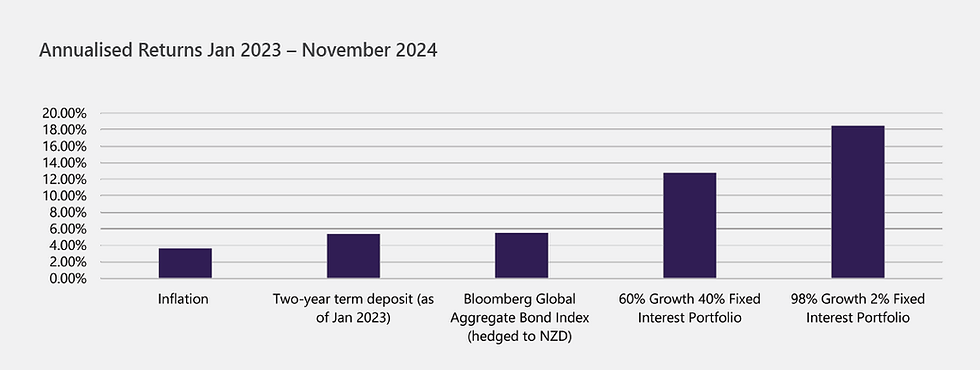top of page


Central Financial Planning
The Hidden Cost of Playing it Safe with Term Deposits
Intro
The end of a year is an opportune time to reflect on financial decisions and the lessons they’ve taught us. In recent years, headlines like "Inflation Hits Highest Level in a Decade" (The New Zealand Herald, 2021) and "NZ Inflation Hits 30-Year High at 6.9%" (RNZ, 2022) have dominated news cycles, fueling widespread concerns about the impact of inflation on everyday life and investment portfolios.
Such alarming reports understandably left many investors questioning, “What does this mean for my financial future?” In the article "The Hidden Price of Playing It Safe: Are Term Deposits Costing You?", we explore these challenges and reflect on how decisions made during uncertain times can shape long-term financial outcomes.
The impact of inflation and rising interest rates
In response to inflation pressures, the Reserve Bank of New Zealand (RBNZ) quickly raised interest rates from the historic lows seen during the post-COVID period.
This move had a notable impact on term deposit (TD) rates, which climbed to 5-7%, making them suddenly more attractive than they had been for over a decade.
New Zealanders responded by shifting significant amounts of their money into TDs. Data from the RBNZ (see chart below) shows that investors moved strongly back into TDs from early 2022, commencing a trend which continues today

With New Zealand interest rate on the rise at eh time, the behavior was not unexpected - higher interest rate often draw investors into fixed-term, 'safer' investments like TD's. By early 2023, average 2-year TD rates had risen to 5.35%, up sharply from around 2.7% in early 2022. For many investors this seemed like a safe and logical move amid volatile markets.
Unfortunately, while inflation helped push interest rates and TD rates higher, it didn’t necessarily mean that TDs became a more attractive investment option.
The reality of TDs as inflation hedges
While TDs offered predictability and stability, they weren’t (and aren’t) the best tool to counter inflation. The chart on the next page shows how several different investments compared over the period from January 2023 to November 2024.
The key insight is that 2-year TDs just barely outpaced inflation before tax, but they underperformed bond funds and significantly underperformed other investment options like balanced portfolios, and aggressive equity- focused portfolios.

In fact, if investors were rolling over TDs with shorter durations (like 6 months), then average TD rates were even lower than those highlighted in the chart above. For many investors in 6 month TDs over this period, their real return (i.e. after tax and inflation) would actually have been negative, particularly investors on higher marginal tax rates.
Why investors chose term deposits
Many investors turned to TDs in early 2023 because of:
• Market losses in 2022: Portfolios and bond funds suffered losses during 2022. Looking at prior annual returns early in 2023 meant facing red ink across nearly every asset class.
• Emotional decisions: With inflation dominating headlines and purchasing power eroding, TD rates above 5% seemed like a logical and enticing safe haven.
• Fear of volatility: Comparing recent losses in equity portfolios to 'guaranteed' returns from TDs made the latter seem like a no-brainer.
Why long-term investing works
Inflation increases the cost of goods and services, but businesses adapt. As prices rise, businesses typically see higher nominal earnings, which, over time, translate into higher equity valuations.
This relationship isn’t linear or immediate, but over the long term, it holds true – and it held true during this period as well. It means that when inflation pushes up prices and, effectively, company valuations, a diversified exposure to company shares can be a very effective long term inflation hedge.
Investors who stayed the course and maintained diversified portfolios reaped the benefits of share growth and market recovery, far outpacing the returns from term deposits.

bottom of page